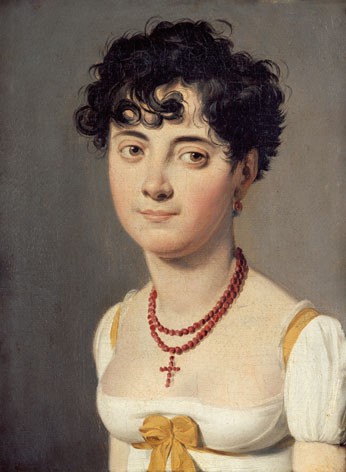Renowned for his paintings of the mores of his time, Louis-Léopold Boilly was also appreciated for his talent as a portrait painter. The model here is Madame de Fouler, wife of Albert-Louis-Emmanuel Fouler, Brigadier General and later Division General, squire to the empress Josephine from 1804 to 1809 (indeed he formed part of the empress train during the coronation), moving later to the service of the emperor in 1810. The general became Comte de l'Empire in 1808 with the name Comte de Relingue.
Typical of this artist's enormous output, this three-quarters bust portrait is set against a neutral background painted onto a traditional canvas measuring 22 by 17 cm which Boilly always had ready in his workshop. Renowned for his ability to catch a likeness and his avoidance of excessive flattery, Boilly was for the most part sollicited by an upper middle class clientele keen on getting their family paintings up on the walls. These small portraits were usually done from one or two sittings and sold for an verge price of 120 francs. The rapidity of execution however never affected the high quality of the painting.
Here, Boilly paints a young woman who is 'up' in fashion. Ever since the Directory, antiquity had been the prevailing style for clothing. The tunic is in the Greek fashion. Its light, almost transparent material merges into a white dress with short sleeves, called in French «à bretelles», a design which left the arms and neck bare. The only colour present is added by the yellow bow and ribbon and the coral necklace. Another typically 'antique' feature is the model's hairdo, a cut called “à la Titus”, which had initially been for men having been launched by the actor Talma but which was soon taken up by the female fashion victims of the Directory and Consulate. The fashion journals as early as an VI (1798) had proposed short haircuts called “à la Titus”, “hedgehog” and “à la Caracalla”. Palette, a hairdresser of the time, even had published a 'Eulogy of the “a la Titus” haircut for women', claiming that the studied disorder of the style “gives an air of youth and replaces all ornaments, jewels and feathers”.
Karine Huguenaud (tr. P.H.)
October 2004
Portrait of Madame Fouler, Comtesse de Relingue
Artist(s) : BOILLY Louis Léopold

- Date :
- circa 1810
- Technique :
- oil on canvas
- Dimensions :
- H = 22 m, L = 17 m
- Place held :
- Paris, Fondation Napoléon (donation Lapeyre)
- Photo credit :
- © Fondation Napoléon - Patrice Maurin-Berthier

